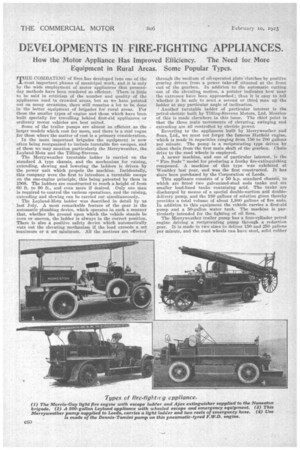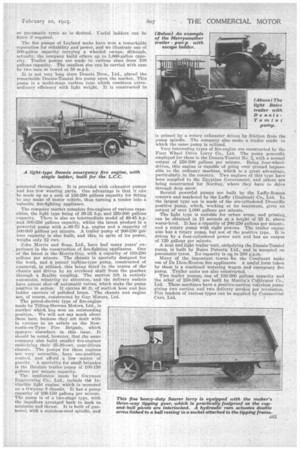DEVELOPMENTS IN FIRE-FIGHTING APPLIANCES.
Page 44

Page 45

If you've noticed an error in this article please click here to report it so we can fix it.
How the Motor Appliance Has Improved Efficiency. The Need for More Equipment in Rural Areas. Some Popular Types.
MLIE COMBATING of fires has developed into one of the most important phases of municipal work, and it is uily by the wide employment of motor appliances that presentday methods have been rendered so efficient. There is little to be said in criticism of the number and quality of the appliances used in crowded areas, but as we have pointed out on many occasions, there still remains a lot to be done in the better equipment of brigades for rural areas. For these the smaller types of engine and those which have been built specially for travelling behind first-aid appliances or ordinary motor vehicles are best suited.
Some of the trailer pumps are almost as efficient as the larger models which cost far more, and there is a real vogue for these where the matter of cost is a primary consideration.
In the more important brigades the equipment is now often being reorganized to include turntable fire escapes, and of these we may mention particularly the Merryweather, the Leyland-Metz and the Tilling-Stevens.
The Merryweather turntable ladder is carried on the standard A type chassis, and the mechanism for raising, extending, slewing and lowering the ladders is driven by the power unit which propels the machine. Incidentally, this company were the first to introduce a turntable escape on the one-engine principle, this being patented by them in 1908. The ladders are constructed to reach a height of from 60 ft. to 90 ft., and even more if desired. Only one man is required to control the various operations, and the raising, extending and slewing can be carried out simultaneously.
The Leyland-Metz ladder was described in detail by us last July. A most remarkable feature of the gear is the automatic plumbing device, which operates in such a manner that, whether the ground upon which the vehicle stands be even or uneven, the ladder is always in the correct position. There is also a positive safety device which automatically cuts out the elevating mechanism if. the load exceeds a set maximum or a set minimum. All the motions are effected through the medium of oil-operated plate clutches by positive gearing driven from a power take-off situated at the front end of the gearbox. In addition to the automatic cutting out of the elevating motion, a pointer indicates how near the extremes have been approached ; thus it is easy to tell Whether it be safe to send a second or third man up the ladder at any particular angle of inclination.
Anothei turntable ladder of particular interest is the petrol-electric built by Tilling-Stevens Motors, Ltd. Mention of. this is made elsewhere in this issue. The chief point is that the three main movements of elevating, swinging and extending are all controlled by electric power.
Reverting to the appliances built by Merryweather and Sons, Ltd., we must not forget the famous Ilatfield engine, which is made in capacities ringing from 150 to 700 gallons per minute. The pump is a reciprocating type driven by silent chain from the first main shaft of the gearbox. Chain drive to the road wheels is employed.
A newer machine, and one of particular interest, is the "Fire Suds" model for producing a frothy fire-extinguishing compound. A machine of this type was exhibited at Wembley last year, and was the first constructed. It has since been purchased by the Corporation of Leeds.
This appliance consists of a 50 b.p. standard chassis, to which are fitted two galvanized-steel soda tanks and six smaller lead-lined tanks containing acid. The tanks are discharged by means of a special double-suction anli doubledelivery pump, and the 180 gallons of solution given thereby provides a total volume of about 1,800 gallons of fire suds. In addition to this equipment the vehicle carries a first-aid pump and a 50-gallon water tank. The machine is particularly .intended for the lighting of oil fires. The Merryweather trailer pump has a four-cylinder petrol engine driving a reciprocating pump through a reduction gear. It is made in two sizes to deliver 150 and 250 gallons per minute, and the road wheels can have steel, solid rubber or pneumatic tyres as is desired. Useful ladders can be fitted if required.
The fire pumps of Leyland make have won_ a remarkable reputation for reliability and power, and we illustrate one of ' 500-gallon capacity carrying a wheeled escape, although, actually, the company build others up to 1,000-gallon capacity. Trailer pumps are made in various Sizes from 100 gallons capacity. The smallest size can be carried with ease by to men or towed at 50 m.p.h.
It is not very long since Dennis Bros., Ltd., placed the remarkable Dennis-Tamini fire pump upon the market. This pump is a multi-stage turbine type which combines extraordinary efficiency with light weight. It is constructed in
gunmetal throughout. It is provided with exhauster pumps and has .few wearing parts. One advantage is that it call be made up as a unit of 150-200 gallons capacity for fitting to any make of motor vehicle, thus turning a tender into a valuable fire-fighting appliance.
The company market complete fire-engines of various capacities, the light type being of 30-85 h.p. and 250-300 gallons capacity. There is also an intermediate model of 40-45 h.p. and 300-350 'gallons capacity, whilst the latest product is a powerful pump with a-60-70 h.p. engine and a capacity of 500-600 gallons per minute. A trailer pump of 200-250 gallons capacity is also built, and this, in spite of its power, weighs only 12 cwt.
John Morris and Sous, Ltd., have had many years' ex
perieuce in the construction of fire-fighting appliances. One of the latest is the-Morris-Guy, with a capacity of 150-250 gallons per minute. The chaSsis is specially designed for the work, and a Patent turbine-type pump, constructed of gunmetal, -is utilized, this being fitted in the centre of the chassis and driven by an overhead shaft from the gearbox through a flexible coupling. The suction lift is entirely autoniatic, reguiriiig •tio attention, and the delivery outlets have patent shut-off automatic valves, which Make the pump • positive in action.:.. It :carries 40 ft. of mictioin 116.4 and has ladder carriers of polished brass. The chassis and engine are, of course, constructed by Guy Motors, Ltd.
The petrol-electric type of fire-engine made by 'Tilling-Stevens Motors, Ltd., is another which has woii an outstanding position. We will, not say much about them here, because they arh dealt with in extenso in an article on the Newcastle-on-Tyne. Fire Brigade, which appearselsewhere . in this issue. It should be noted, however, that.the .saroe company also build smaller' fire-engines
• embolying their 25-30-cwt. gear:driven.
chassis. The pumps for these engines are very accessible, have one-position control, and afford a low centre of gravity. A speciality for steall brigades is the Bantam trailer pump Of 100-150 gallons per minute capacity.
appliances 'made by Gwynnes
Engineering Co., Ltd., include the Invincible light engine, which is -mounted on a Gwynue 8 chassis. It has a pump capacity of 100-150 gallons per minute. The pimp is of a two-stage type, with the impellers arranged hack to back to minimize end thrust. It is built of gunmetal; with a stainless-steel spindle, and
is primed by a rotary exhauster driven by friction from the pump spindle. The company also make a trailer outfit in which the same pump is utilized. .
Very interesting types of fire-engine are constructed by the Four Wheel Drive Lorry Co:, Ltd. The pump generally employed for these is the Dennis-Taraini No: 2, with a normal output of 250-300 gallons per minute. Being four-wheeldriven, this engine is capable of going over ground impass able to the ordinary machine, which is a great advantage, particularly,in the country. Two engines of this type have been supplied to the Egyptian Government; and others are being constructed for Norway; where they have to drive through deep snow.
Several powerful. pumps are built by the Laffiy-Somuct concern and marketed by the Lailly (England) Co., Ltd. In the largest type use is made of the six-eylindered Drouville positive -Dump, which, working at its maximum, gives an output of over 1,000 gallons per minute.
The light type is suitable for urban areas, and priming can be obtained in 13 seconds at a height of 25 ft.. above water-level. It has a capacity of 200-250 gallons per minute, and a rotary pump with eight pistons. The trailer engine also has a rotary pump, but not of the positive type. It is driven by a four-eylindered power unit and has an output of 120 ,gallons per minute. .• •
A neat and light trailer unit, embodying the Dennis-Tatn. ini pump, is built by Bain°. Patents; Ltd., and is mounted on pneuinatin tyres. Its capacity is up to 200 g.p.M.
Many of the important towns im the Continent make use of De Dien-Bouton fire-appliances. A useful form taken by these is a combined Watering wagon and emergency fire pump. Trailer units are also constructed.
Two trailer pumps, one of 150-200 gallons Capacity and the other. of 250-300, are built by Martin's Cultivator Co.,' Ltd. These machines have a positive-Suction valveless pump giving two suction and two delivery Strokes per revolution. Fire tenders of various types can be supplied by Commercial Car's, Ltd.














































